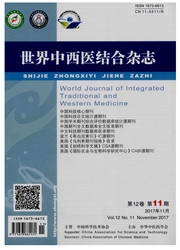

 中文摘要:
中文摘要:
近年来,随着研究的深入,学者们从玄府学说探讨缺血性中风与脑缺血再灌注损伤(CIRI)的病机,认为中风病存在玄府闭塞、气血不通、神机不遂的病机,脑之玄府闭塞是缺血性中风的发病关键,治疗强调宣通玄府。现代医学研究发现,CIRI后血脑屏障(BBB)通透性改变,具有中枢神经系统(CNS)疾病治疗作用的药物大多不能通过BBB,而芳香开窍药能够双向调控BBB通透性,从而保护脑组织。通过对芳香开窍类中药宣通玄府治疗缺血性中风的作用机制的分析,探索脑之玄府与BBB在分布、作用特点等方面的高度共性,认为芳香开窍药治疗缺血性中风的作用机制在于其能双向调控CIRI后BBB通透性、减轻脑水肿、调节相关蛋白,在中医则能开通玄府,二者在治疗机制上亦有高度共性,这丰富了玄府开阖理论的实质内涵。
 英文摘要:
英文摘要:
In recent years, with the deepening of the research, scholars discussed that pathogenesis of ischemic stroke and cerebral ischemia - reperfusion injury ( CIRI ) from Xuanfu theory and thought that the pathogenesis of the stroke included Xuanfu occlusion which played an important part, qi - blood blocking and keeping spiritual mechanism free and the treatment principle emphasized dredge Xuanfu. Modern medical re- search found that blood brain barrier permeability changes after CIRI (BBB), with the central nervous system (CNS) drug therapeutic effect are not through BBB, and bidirectional regulation of BBB aromatic resuscitation drug permeability, so as to protect the brain tissue. Modern medical research found majority of the medicine which had the therapeutic action to CNScannot get through BBB which its permeability changed after CIRI, but TCM of resuscitation with aromatics could bi - directionally control the permeability of BBB and protect brain tissue. The mechanism that ischemic stroke was treated with dredging Xuanfu which utilized traditional Chinese medicine of resuscitation with aromatics was analyzed to explore the high similarities of the Xuanfu and BBB in distribution and function characteristics. The result indicated that its mechanism was that it could bi - directionally control the permeability of BBB after CIRI, reduce the content of water obviously and regu- late gap - associated protein. It could also dredge XuanFu according to Chinese medicine theory. These two theories had high similarity in the treatment mechanism, which made the connotation of Xuanfu - opened - closed theory more plentiful.
 同期刊论文项目
同期刊论文项目
 同项目期刊论文
同项目期刊论文
 期刊信息
期刊信息
